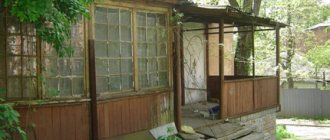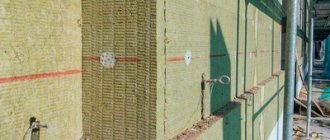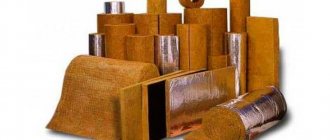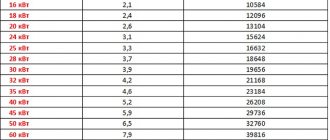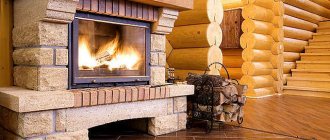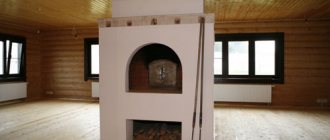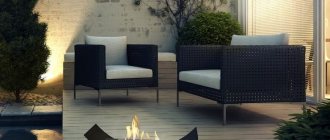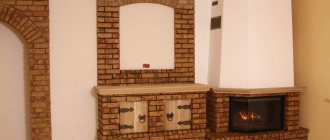Not every person knows that all types of fireplaces, represented by a huge number of models, have very specific, established standard indicators for some technical parameters. These parameters include the dimensions of the main node elements. When constructing a fireplace, you should adhere to these values, since deviations can lead to disruption of the functions of the device. Any fireplace must cope with the same tasks:
- remove heat resulting from fuel combustion;
- ensure removal of combustion products;
- provide oxygen supply to the furnace.
Drawing of a wall fireplace
The history of fireplace construction is rich in experimental discoveries that accumulated in the form of experience that was passed on from the master to his student. Today, many professional stove makers do not even think about why the chosen standard project has fixed dimensions. His knowledge comes down to memorizing indicators for different types of stoves. Meanwhile, there are quite good reasons for standardization. Let's study in more detail the dimensions of the fireplace, its main characteristics, which are an indicator of its proper operation.
Tips and tricks
So, you have decided to complement the interior of your home with a stylish and original fireplace.
First you need to determine for what purposes this design is needed:
- As a decoration in the interior of the room. An electric or bio-fireplace is perfect for these purposes. You can use these models as a reliable and practical heater in cool weather.
- For additional heating of the home.
- As a complete heating of the room. In this case, you can opt for a fireplace stove.
When choosing the required model, you need to carefully study the technical specifications and carefully weigh all the pros and cons of the upcoming repair. The stove model you like should be practical, reliable, and fit perfectly into the interior of the room. Installation and subsequent operation of the fireplace structure should not create great difficulties.
There are a huge number of types of fireplaces, all of them differ in technical characteristics and design. It is quite difficult to choose a suitable, reliable, economical, stylish and original model. Many people decide to make a fireplace with their own hands, while others prefer to purchase a ready-to-use version of a decorative stove. In any case, you need to think through all the details in advance. Only then will the fireplace decorate the room and delight with its appearance and warmth.
Calculating a fireplace with an open firebox: important aspects of its creation
When organizing the construction of any fireplace, we must not forget about the important recommendations of experts. The most important thing is to follow all the dimensions, since they play an important role in the characteristics of the fireplace. When you start making preliminary calculations, follow all formulas and take into account possible factors and aspects.
Important aspects include the following:
- The size of the firebox of almost any fireplace should not be less than 25 cm and no more than 40 cm. Such dimensions are considered optimal for household fireplaces with average power. These varieties are the most common. If we talk about a sauna stove, then the width of the firebox can be a little more than 40 cm.
- If you doubt the correctness of the calculations for your fireplace design, you can check them in a simple way. The width of the firebox must match the width of your firebox door.
- Please note that the difference in size will significantly reduce the heat flow, and the fuel will burn much more slowly than it should. Either way, improper sizing will reduce the use and efficiency of your fireplace.
Experts always try to pay special attention to the firebox, because its parameters are the most important indicator. The minimum size of the firebox should be 80 cm, the maximum 100 cm. Very often, when building a fireplace, it is impossible to achieve this indicator, and the way out of this situation is to increase the level of the afterburner chamber. If the size does not match, then all the flammable gases that were formed in the process will not burn.
Installed in furniture pieces
Advanced technologies make it possible to harmoniously fit fireplace inserts into ready-made cabinets. This original solution decorates not only the room, but also the furniture set. The hearth is framed and mounted in a prepared niche. The idea of mortise-mounted household appliances has long been practiced in kitchen sets.
MDF or plastic from which furniture elements are made cannot but impose restrictions on the fireplaces built into them. This occurs due to the sensitivity of surfaces to temperature changes.
The built-in hearth should only serve as the illusion of fire. The most neutral and most successful option would be an electric fireplace without a heating function. Another alternative solution could be a built-in bio-fireplace, the heat from which is also minimal.
Metal elements in masonry
When installing fittings into the seams of the fireplace, do not forget to leave gaps of a few millimeters. This measure is due to the fact that when heated, the metal expands, and if the fit is tight, the masonry can simply crack. Therefore, the less metal there is in the fireplace body, the better.
However, it is impossible to do without a smoke cap and a fireplace grate. Attach them directly to the bonding solution without using additional fixation - they will stay in place just fine as is.

Shapes and styles
It is necessary that the fireplace installed in the room is in harmony with the overall interior and looks like a full-fledged element of it, and that the shape and decorative design of the fireplace are chosen correctly.

Classic style
This style is always relevant and in demand. Typically, classic fireplaces are shaped like the letter “P”. There are several varieties of classics that are worth considering separately from each other.

- A traditional version in the English style, where the electric hearth has a laconic appearance. In this case, there is an open firebox, which is equipped with a sophisticated forged grate. Natural colors are used to create an electric fireplace.
- Empire style, which is characterized by the presence of many decorative elements. There are often sculptures, gilding, garlands and other decorations here.
- Rococo is a style ideal for spacious rooms. The decoration of the fireplace is whimsical and luxurious, characterized by asymmetry.
- Baroque, which will look attractive only in a large room, as it is distinguished by the presence of a large number of decorations. If you install such a fireplace in a small room, it will look too bulky.
Modern
In this case, the design of the corner fireplace is similar to the classic version, but in modern style other materials are used, for example, forging and cast metal elements. Some models are made with glass inserts.

High tech
Minimalism and functionality – these words can describe this style. The shape of the firebox should be unusual: it can be a pentagon or a triangle. There are practically no decorative elements here. This style is most relevant in studio apartments.
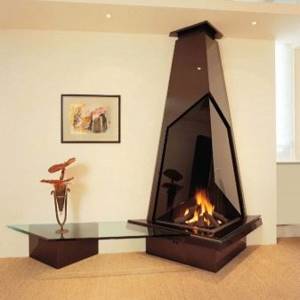
Country style
Visually, this fireplace resembles an old-fashioned stove and is usually decorated with brick or stone trim. It is laid out in the shape of an arch. The firebox can be of two types: open and closed.
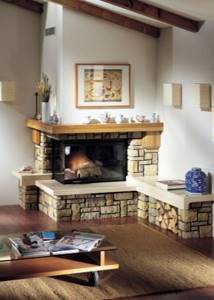
Laying and preparing the foundation
fireplaces for brick houses usually have a large mass, which is quite difficult for the house to withstand. In this case, you will need to build a separate foundation for the fireplace.
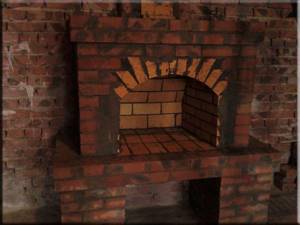
Before starting construction work, it is important to take some tips and nuances as a basis:
- Build the foundation so that it is completely separate from the foundation of the house. There should not be even partial or slight contact between them;
- Make the foundation larger than the overall dimensions of the heating unit itself. It should protrude from each edge by approximately 9-12 centimeters;
- The pit should have a depth of about 50-70 centimeters;
- The foundation will end without reaching the height of the floor by one brick or 60-70 millimeters;
- Masonry work on the stove is carried out only after the foundation is completely assembled and well, completely dry.

Bricks or pre-prepared concrete are used to assemble the foundation. Construction on a concrete base is considered the most difficult. Let's take a closer look at it.
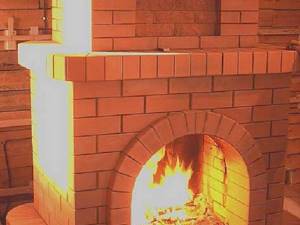
First of all, a pit is dug into which it is necessary to fill with crushed stone in a layer of up to 150 millimeters. After this, the formwork is installed, which must be insulated and treated with special resins or a layer of roofing material. All this must be filled with a solution based on sand and cement in a ratio of 3:1. We level the surface using a building level and cover it with a polyethylene layer and leave it to dry completely for 6-10 days.

Before laying the stove, it is necessary to lay 2-3 layers of roofing felt on the surface of the foundation.
What power should I choose for an electric fireplace?
The power of the heating element installed in the fireplace also plays an important role. The minimum possible value is 500 W, and the maximum value rarely exceeds 2 kW. Obviously, the more powerful the heating coil, the more electricity the device will consume during operation. The choice of this option should be based on the following factors:
- First of all, you should determine the function of the electric fireplace in your room. Either it will just be an interior decoration, or you plan to use it to heat the room. This is especially true in the autumn and spring. When the central heating system is still or no longer working. In the first case, the power consumption will be minimal, and in standby mode it may not exceed 100 W;
- Also, do not forget that many modern models have the ability to use both functions simultaneously or separately. Therefore, if funds allow, then it is better not to immediately refuse to buy a fireplace with a heating function;
- The power should be selected based on the area of the room in which the device will be installed. Accordingly, the more spacious the room, the more powerful the heater will be needed. The maximum value of 2 kW is designed to heat 20-25 square meters. When calculating power, rely on the recommendations of specialized literature, which states that 1 kW of energy must be spent to heat 10 square meters;
- And most importantly, do not forget about your own safety. If you decide to purchase the most powerful model, make sure that your wiring can withstand the load. Ideally, a separate cable of the appropriate cross-section will be allocated for the fireplace, connected to the meter through an automatic machine.
Conditions for normal traction
Everyone has heard of the term cravings. Even without knowing the definition, you can intuitively imagine what it is. There are opinions that this is a pressure difference or temperature difference between the upper and lower points of the chimney.
However, this idea is not entirely correct, because with a small pressure difference, thrust can be increased due to other factors. Therefore, draft should be understood as the speed of movement of air masses through the cross section of the chimney. It may be increased, decreased or normal. The average speed should be 0.25 m/s.
It is impossible to measure the speed of movement of combustion products at home. Before lighting the fireplace, it is recommended to make sure that there is draft. To do this, you should observe the behavior of the flame of a burning piece of paper, and the magnitude of this draft can already be assessed by the behavior of the fireplace itself after kindling.
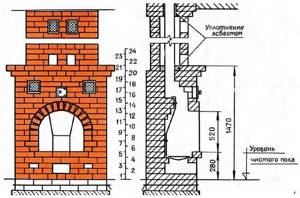
Brick laying scheme
In order not to rely on chance, all factors influencing the amount of thrust are carefully studied. Among them are dynamic (atmospheric pressure, precipitation, wind, damage to the chimney) and statistical, depending on what dimensions of the fireplace were chosen during construction, what its width and height are.
What is the principle for choosing sizes and design?
All construction work according to the rules begins with projects. It is necessary to accurately calculate all the required dimensions of a brick fireplace; the power and aesthetic appearance depend on this. The most important thing is a guarantee of safe operation.
On a note. There are no ideally calculated ready-made dimensions for a fireplace, since houses are different, and manufacturing materials also differ in shape and quality. You can only roughly focus on the standard brick size.
Simple DIY fireplaces are now a very common occurrence.
It is important to correctly determine the dimensions of the combustion chamber. The calculation is performed as follows:
The calculation is performed as follows:
- The area of the room is divided by 100. So, for example, the living room is 30 square meters. m, the firebox will be 30 cm.
- Now the depth. When laying the fireplace firebox, the proportions are maintained: the depth is 1.5-2.5 times less than the width. In this example, you can take a conditional proportion of 1:2. That is, the depth is 37.5 cm (one and a half bricks), and the width is 0.75 m (3 bricks).
- The height of the combustion part is one and a half times greater than the width. As a result, it turns out that a combustion chamber 3 bricks wide has a height of slightly more than one meter. In reality, it will be necessary to lay out 15 rows of masonry.
- The smoke channel in relation to the firebox area is 1:10-15. It can be made wider. However, the height of a straight section cannot be less than 3 meters and more than 4 meters. These parameters are maintained for good traction.
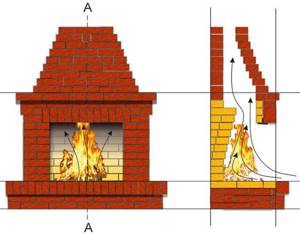
To imagine the design of a brick fireplace, it is better to stock up on a ready-made drawing so as not to make mistakes in the calculations. There are ready-made drawings of fireplaces, from which you can choose the appropriate option.
A fireplace will help not only as an independent source of heat in the off-season, but also as an addition to the main heating of the premises. When opportunities allow, there is experience in the construction of such structures, complex fireplaces with additional functions are chosen. This could be connecting a water circuit, heating water, or a hob. A classic brick fireplace is not very large in size, and even a novice home craftsman can handle its construction. There are now a lot of types of fuel for a fireplace, but the cheapest is still ordinary firewood.
Chimney - special attention
When designing, it is important to correctly calculate the size of the chimney for the fireplace. It is calculated based on the area of the portal and should be 10-15 times smaller than it .
Advice: knowing the dimensions of fireplace inserts, you can, of course, calculate the size of the chimney, but you should know that this is a very important undertaking. If you do not have much experience in this area, it is better to entrust it to a professional, because no one has canceled such a concept as reverse thrust. Carbon monoxide poisoning is deadly! Remember this!
You can obtain more detailed information about chimneys by reading the relevant articles on our portal. Various chimneys, including fireplace chimneys, are described in detail there.
Dimensions and material - direct relationship
When setting up a fireplace, the dimensions of the chimney and firebox are not the only ones you need to know. For example, someone is more interested in the question - how many bricks do you need for a fireplace? The question is not idle and quite understandable.
But before we answer it, we want to add a little to all of the above. In our article, when considering methods for calculating and determining the dimensions of a particular part, we did not mention materials. Why are we talking about this only now? Because this is directly related to the question of the number of bricks.
Selection of location and dimensions
Previously, we calculated the firebox dimensions; the fireplace and its dimensions directly depend on the material from which it will be made. Knowing the material, you can quite accurately calculate the dimensions and determine the location for the future fireplace.
On our pages we have already described how to choose a place, so we will not repeat ourselves. The only thing you need to add: knowing the placement rules and correctly calculating the dimensions, you can install this unit in the best possible way.
Foundation
After determining the dimensions of the firebox and chimney, you should calculate what the foundation should be.
The foundation is built based on the weight of the future structure. If the weight of the fireplace is less than 700 kg, then there is no need to make a foundation, however, often the weight of the structure is significantly higher, so a foundation is necessary.
When building a medium-sized fireplace, as a rule, a foundation is made with a depth of 0.75 to 1 meter. These figures are valid if you plan to live in the house permanently and the soil underneath will not freeze. When building a fireplace in a summer cottage, the foundation must be buried to the depth of soil freezing.
Please note: it is extremely important that the foundation of the fireplace and the foundation of the house are free of bandages, as these structures may have different settlements, which will lead to the formation of cracks.
Basic mistakes
Unfortunately, this does not always happen. In some cases, one or several rules are violated:
- The right size fireplace for a specific room.
- Proper placement in compliance with its dimensions for a specific room.
Knowledge is power
This knowledge is not necessary if you do construction with your own hands; it will also be useful to you when you hire outside workers for construction.
Nowadays, there are “specialists” who are able to build something that at first glance looks and works well, but upon closer examination turns out to be just another flaw. Knowledge will help you perform proper supervision of construction work in your home.
Number of bricks - counting orders

As for the quantity of bricks, we will not give detailed calculations for one simple reason - they will not be useful to you at all. Indeed, for each specific case a completely different calculation is required.
Nevertheless, we will try to explain in a nutshell how you can approximately determine the amount of brick. Knowing the dimensions of the fireplace, the dimensions of the brick and the thickness of the seam, you can quite accurately calculate its quantity.
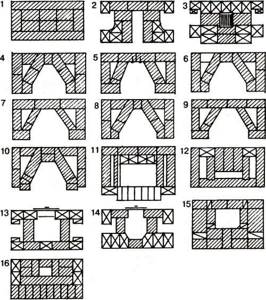
Orders.
- In any case, when arranging fireplaces, its dimensions are transferred to orders of magnitude.
- Having the orders in hand, use them to count the number of bricks.
- Don't forget about the seams. The thickness of the seam in this case plays an important role.
We have already described how to properly arrange seams in articles about masonry on our resource, so we will not repeat ourselves. By adding up the number of bricks in all orders, you get the total quantity. If the base is made of brick, do not forget about it.
Our advice: add more bricks to the received amount 10%.
For corner fireplace
As already mentioned, the order is a detailed diagram that indicates the position of each brick. In addition, ordering will greatly simplify your task and help you calculate the required number of bricks that you will need when building a stove or fireplace; moreover, you will be able to avoid unnecessary waste.
The arrangement of a corner fireplace is practically no different from the simple or classic version; you just need to take into account a couple of points. One of these important points is that the foundation should rise 10 centimeters above the floor. You can follow this procedure by following the instructions.

At the first stage, it is recommended to lay the foundation using clay mortar. Continue doing this until the fourth position (row), where you need to divide the fireplace into two blocks, covered by a stove.
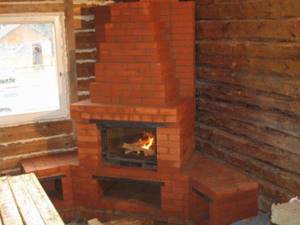
Second phase. The first block should be designed as a niche for logs, and the second block as a front façade. At the next stage, it is recommended to use refractory bricks, and here you should form the base for the stove.
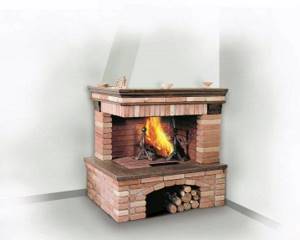
At the fourth stage, after covering the fireplace itself with a slab of solid metal, for example, steel, the construction of the fireplace should take place according to a pre-prepared scheme up to the twelfth row. In order for the entire heating system to work efficiently and without any failures, it is also better to use fire-resistant bricks for interior wall decoration.

At the next stage, it is necessary to continue laying, as at the beginning, according to a pre-prepared pattern until the twenty-seventh row. If you want to add extra rigidity, you can install iron corners between the bricks. They can be made by hand.
And finally, at the sixth stage, it is necessary to make valves on top of the building. The corner masonry of the fireplace differs in many ways from the classical one, but is not at all impossible.

7 photos
Foundation calculation
The foundation must have a laying depth of at least 500 mm. If you install the device in a house that is not constantly heated, then increase this value by 200 mm from the depth of seasonal soil freezing.
Separate the foundation of the heating system from the main foundation with a sand bed. The minimum distance between these structures is 100 mm.
The upper plane of the foundation should not reach the level of the finished floor by 150 mm. The base for the heating device should be 5-10 cm larger from its body on all sides.
Fireplace foundation
Design
The style of the fireplace should be chosen based on the overall interior of the room.
Finishing the wall with a fireplace with stone up to the ceiling will help visually increase (or emphasize) the height of the room. Such a fireplace will inevitably become the center of the interior, so you should approach its design wisely. The stone finish will contrast interestingly with the wood, which will help add a “zest” to the interior of the room. The color and size of the stone can be absolutely any - it all depends on your imagination. Moreover, this decoration will fit perfectly even into a modern interior, giving the room a cozy and warm atmosphere.
Modern fireplaces look more sophisticated
Such fireplaces look especially interesting against the background of light-colored walls. Also an original solution would be to place a fireplace in the bathroom or dining room.
A metal fireplace is quite difficult to fit into the interior if there are no other metal parts in the room, but it will fit perfectly into an industrial-style room. This design will also look good in modern apartment or house designs. It can be interestingly integrated into other interiors by adding matching elements made of metal or a metallic shade.
A fireplace covered with wood can bring coziness to any interior. It will fit well not only into rustic, but also into modern room design, contrasting with simple details. The combination of wood and stone looks good. It is worth knowing that for safety reasons, wooden trim can only be used with electric fireplaces with a metal frame. Furniture needs to be selected carefully. For example, “wild cherry” furniture is suitable.
The fireplace can be placed in the corner of the room. This arrangement will help to rationally use the free space of the room, since corners are used quite rarely. This design is perfect for small rooms. In addition, the interior with a corner fireplace will be more “smooth”. However, it is worth carefully considering the shape and design, since not all types of fireplaces can be easily installed in a corner. This hearth can be decorated in any style. A TV or clock is hung above it.
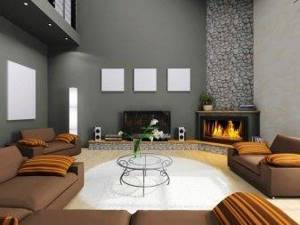
Scandinavian fireplaces have a simple and laconic appearance, so the furniture in the room should be appropriate. They can be of completely different shapes and sizes, and, regardless of this, give the room a special look. They can also be made from different materials. Such designs, due to their shape, fit perfectly into the corner of the room. The most popular design color is white, as it emphasizes the simplicity and “lightness” of such a fireplace. The wall and cabinet should not be bright. A wood sticker can be used.
Standard fireplace dimensions (video)
The dimensions of the fireplace are a very important detail during construction. As you can see from the article, failure to match the dimensions leads to irreversible consequences, all your efforts become in vain and most likely the structure will be dismantled. Don't neglect the rules. If you are not confident in your capabilities, it is better to contact a professional who will certainly create an ideal and correct model of your fireplace.
08/24/2017 3738 Pechnik (Moscow)
Not many people know how important it is when choosing either a ready-made purchased model or when preparing an assembly diagram to indicate and pay attention to the dimensions and design parameters.
The efficiency of the device, its position and viewing angle in the interior directly depend on this aspect. Due to its location, a corner fireplace does not always look equally good and advantageous; it requires preliminary selection of the most suitable location and other parameters.
Knowing the dimensions of the corner fireplace, you can easily choose a unique design for it that is most harmonious and compatible with the overall interior of the room, calculate its power and purchase all materials and accessories.
For detailed information, we also recommend watching the video in this article.
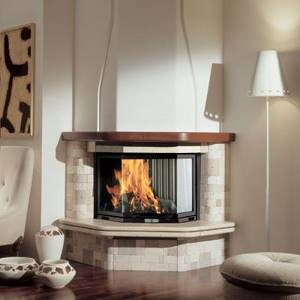
The best built-in electric fireplaces
Those buyers who care not only about functionality and quality, but also about the method of installing the device, should know that fireplaces are structurally divided into a portal and a hearth - removable or built-in. Built-in modifications can boast of particular popularity, as they have one significant advantage - saving space. In addition, they fit well into any design solution of the room. They can be built into cabinets, walls, cabinets and other furniture. The TOP included 4 models from previously announced brands.
Dimplex Viotta
Fireplace from an Irish manufacturer, equipped with a realistic Optiflame flame effect. It works both in parallel with the heating option and separately without it. Thanks to this separation, you can save energy, since the fire simulation will consume only 120 W. The front wall is protected from heat, so you don't have to worry about pets and children. The device does not produce harmful emissions, as is the case with gas heaters. The body is made of plastic, metal and glass, there is a mode switch, 2 kW power, controlled by a remote control.
Advantages
- Built-in installation;
- Calm design;
- Realism of flames and smoldering wood;
- Remote control;
- Easy to install.
Flaws
- For installation on the floor, a portal is required for stability;
- Diodes are missing.
The device supplies heat from below; if it is intended to be installed not only in a wall or furniture niche, but also on the floor, an additional purchase of a special device for fixation will be required.
RealFlame 3D FireStar 33
A worthy model with 3D flame simulation technology, and using the control panel you can adjust the height of the fire, the flickering effect of coals thanks to the operation of 7 halogen lamps. Such a device can be installed in any room, from the living room to a small bedroom due to its dimensions of 68.2 x 87.0 x 30.5 cm. The operating power can be 1500 W, while heating is carried out over a room area of up to 30 m². There are 2 heating modes; in case of failure, the protective function and automatic shutdown will work. Also, we can’t help but rejoice at the built-in steam generator function, which creates an imitation of smoke and controls optimal humidity.
Advantages
- 2 heating levels – 0.75 and 1.5 kW;
- Realistic flame and smoke effect;
- Installation of installation in standard niches;
- Remote control;
- Sound accompaniment in the form of crackling firewood;
- Overheat shutdown function.
Flaws
- The price is higher than competitive manufacturers and models;
- The fan heater may emit a “technical” smell.
Visually, the fireplace is simply mesmerizing; installation of the device is quite easy and quick. An electric fireplace built into the wall delights the owner with a 33-inch diagonal hearth.
Glenrich Premier S14
The Russian manufacturer offers an excellent built-in model for the home, cottage or any organization. The latest technology was used in development, resulting in a masterpiece of engineering, the Glenrich Premier S14. The main “bun” of such a device is the effect of live fire and the ability to be installed in a niche. The case is made of stable steel, dimensions - 76x140x35 cm. The operating power of the device is 2 kW, heating is 20 m², controlled remotely using a remote control.
Advantages
- Two modes for heating the home;
- Fan heater;
- Thermostat;
- Ability to regulate temperature;
- Reliability due to the steel body.
Flaws
- Heavy weight;
- Price.
Despite the fact that the width of the device is 1.40 meters, the depth is only 35 cm, thanks to which the electric firebox can be successfully integrated into the interior. Using the remote control, you can change the brightness of the picture illuminating your apartment or house.
Electrolux EFP/W-1200URLS
Electrolux, a well-known brand for the production of multifunctional and reliable electric fireplaces, has offered a built-in model EFP/W-1200URLS. During the development and creation, innovative technologies were used. The most important advantage of such a device is its modern and incomparable design, rounded shape, sophisticated look, large width and ultra-thin depth, 4 color options to choose from. The body is made of MDF, the inside is lined with metal heat-resistant tiles. Flame and heating do not depend on each other, which means they can work separately or together.
Advantages
- Imitation of Real Fire fire and sound;
- Instant heating;
- Unique appearance, design, rounded wide panel;
- Operational safety;
- Remote control;
- Brightness adjustment.
Flaws
- Price;
- Large width requires a corresponding niche.
The device can be used simply for decoration, including only the flame image function, or it can heat the room with several power modes.
How to make it yourself
When you have decided where the fireplace will be located, you can begin manufacturing. First, drawings are prepared, which indicate the dimensions of all parts of the structure, and calculate how much and what materials will be required.
Recalculate the results several times - it’s better than redoing something later
Drawing
Think in advance about what the portal will look like; the result of the work directly depends on the correct foundation. To get a high-quality and beautiful portal for the fireplace, first draw a sketch of it. It is best to draw the future product in life size, this will help you evaluate how it looks in the chosen place. Consider the dimensions and features of the room; drawing up a sketch indicating all dimensions will help determine the required amount of material.
After preparing the drawing, buy everything you need for the job.
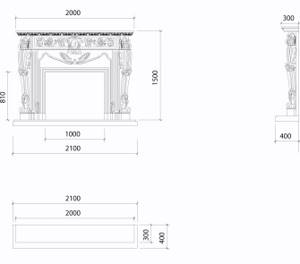
Option drawing of a portal for a fireplace
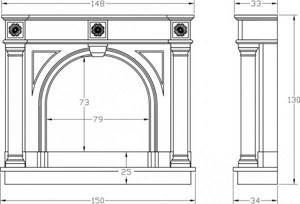
Variant of the drawing of the fireplace portal
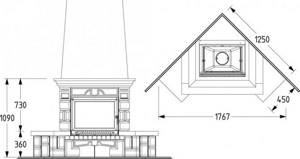
Portal for a corner fireplace made of wood
Design layout
It is no coincidence that it is no coincidence that craftsmen advise preparing a small mock-up of the product in advance.
The layout will allow you to evaluate possible ways of attaching parts, design features, and will tell you where mistakes were made.
If you are making a portal for the first time, the layout will allow you to avoid screwing up the work. It will help you determine as accurately as possible how much material and fasteners will be needed for the job. It is convenient to make a test model from cardboard or foam.
Manufacturing
The sequence of manufacturing a plasterboard portal for an electric fireplace:
- In the place where the fireplace is installed, mark its main elements on the floor and walls.
- Make the frame of the future portal from a metal profile (you will need a rack and guide profile), fix it on the wall surface.
- Make the bottom of the frame from the profile, then make a reinforced frame with a firebox. To strengthen the structure, transverse elements cut from a rack profile are attached every 15-20 cm.
- An electric fireplace is installed in the frame. This fitting will allow you to detect possible flaws, for example, if the fireplace fits very tightly, in this case the dimensions of the firebox are increased - you need to unscrew the profile, move it to the required distance and secure it again.
- Before installing drywall, you need to prepare the holes located opposite the exhaust ducts of the electric fireplace.
- After this, the structure is sheathed with plasterboard, securing it with self-tapping screws with fine threads up to 25 mm long.
- GVL sheets are treated with a deep penetration primer.
- Before attaching decorative elements, you need to putty the surface, glue a corner profile to protect the corners from accidental chips.
- If you decide to paint the portal, then treat its surface with fine sandpaper. If you want to cover it with tiles, then the ceramic elements are simply glued to the drywall.
- The mantelpiece is made of 2 layers of plasterboard. You can display trinkets and photographs on it. It needs to be reinforced with an additional profile and firmly fixed to the wall surface.
For decoration, you can make the foot and decorative sides of the portal; they can be made using plaster or stone decorative elements.
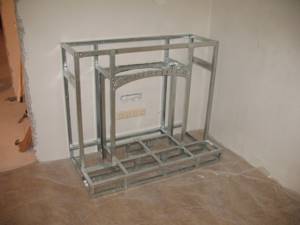
Installing the base of a decorative fireplace and creating a frame

Sheathing the box with plasterboard
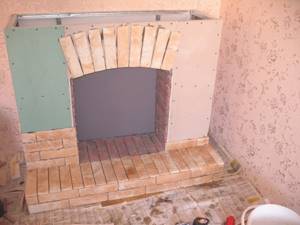
Finishing with facing material
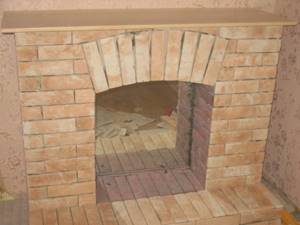
The top shelf is made of solid wood, the bottom of the fireplace is made of stone
The described sequence for making a portal can also be used when installing a false fireplace in an apartment, but for it it is advisable to install a mirror on the back wall, create a device simulating fire, etc.
Making the right choice
In order not to make a mistake when choosing a fireplace, you need to figure out what functions it should have, what size will be optimal and take into account various parameters, which we will consider in more detail later.
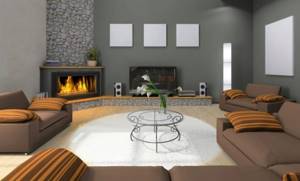
Functionality or decorativeness?
Purpose is the main criterion on which you should base your choice of electric fireplace. If you just need an attractive element that will decorate the room, then there is no point in overpaying for models that are equipped with a heater, and such an addition will affect the amount of energy consumed. In a situation where appearance is important rather than functionality, the choice should be made on decorative models
Just pay attention to how realistic the flame is. If you need an additional source of heating, then models with heating elements are what you need

What is the power of heating devices?
If you decide that you need an electric fireplace, complemented by a heater, then you definitely need to pay attention to the power and the ability to adjust the modes. Typically, the power on such devices is no more than 2 kW, and they are equipped with the ability to regulate temperature
To heat a room of 10 m2, you will need no more than 1 kW of power.
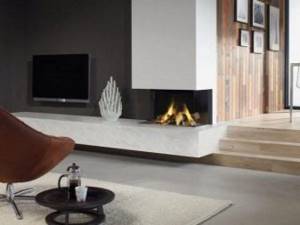
Built-in model or free-standing?
If you are considering a built-in option, then such a fireplace can be built into a pre-prepared niche or into a special portal
It is important to note that today you can purchase a built-in electric fireplace along with an installation portal. Thanks to this design, you can achieve maximum proximity to a traditional wood-burning fireplace
Models that can be located separately are visually similar to a metal stove or a compact fireplace. They are easy to use. Owners of such fireplaces note the ease of movement, so you can periodically easily change its location in the house.

Management and availability of additional options
Electric fireplaces are characterized by the fact that they do not require the preparation of firewood and lighting the fire. You can control the fireplace using a special panel or remote control. With just a few button presses, you can turn on the flame, set the heat level, turn on sound effects and program shutdown. Before purchasing a particular model, study what functions it will please you with. The number of options and additions affects the final cost of the fireplace
It is important to note that installing and connecting an electric fireplace will not cause any difficulties. For this you do not need builders or specialists
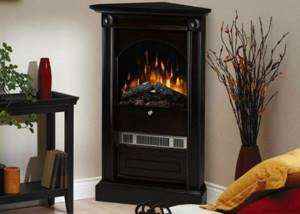
There is a wide range of these products, and this leads to difficulties in choosing. First of all, check out trusted manufacturers, as they offer a high-quality and durable product. The compactness of the corner electric fireplace will allow you to decorate any room in your home. The room in which the fireplace is located looks luxurious. In such a room it will be pleasant to organize receptions and spend family evenings. With this device you can create an intimate atmosphere in the bedroom or add coziness to the dining room. Even in the kitchen, a fireplace will look great.
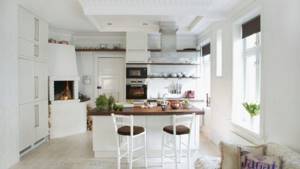
For more information about the advantages, disadvantages and features of corner electric fireplaces, see the following video.
Height adjustment
To adjust the height of the heating device, special bolts are used, which are installed on its legs, or using supports. To set the required distance from the bottom of the firebox of a brick structure to the floor, lay several rows of bricks. Basic requirements before placing the combustion chamber in height:
- you need to ensure a distance to the floor of 300-400 mm;
- if there is a niche for firewood under the firebox, this distance may be greater;
- When calculating the placement of the bottom of the combustion chamber, please note that you need to take into account the structure of the floor with all its components. Think about this when planning your heating system.
Fireplace size calculation
Heat from an electric fireplace
In addition to its purely decorative function, an electric fireplace can also heat the air in the room where it is installed.
For this purpose, a simple electric heater, already familiar to us, is built inside it - a heating element. Which, heated by the passing electric current, heats the air blown into your room from the electric fireplace using a fan.
Now, I think, you yourself will be able to answer the question - what is the main power of an electric fireplace spent on - of course, on the operation of the heating element, on heating the air.
Accordingly, if you want to not only look at the flames, but also feel the heat from your electric fireplace, you must consider the presence of a tubular electric heater inside. It is on heating the heating element that the lion's share of power consumption is spent.
Related Posts
- How to install a stove in the house?
- How to make a fireplace from plasterboard with your own hands
- Review of models of stationary and portable gas fireplaces
- Heating for home
- Brick fireplace
- Do-it-yourself stove-fireplace
- Electric fireplace installation
- Fireproof heat-resistant glass robax and ceran from the German manufacturer schott
- Corner fireplace in the interior +70 photos
- Tiles for the stove: types and their features
- Decorative decoration of the fireplace
- Why does the air conditioner gurgle when not working when there is wind?
- Fire-battery 7b (thermophor)
- Homemade Russian stove on the street under a canopy
- How to update old tiles in the bathroom
- How to glue fiberglass correctly?
- Why chimneys become contaminated with soot and how to get rid of it yourself
- Which door to choose for a stove or fireplace?
- The door handle creaks: causes of the problem and solutions
- Uninterruptible power supplies for heating boilers of any type
- Restoring the handle of a plastic window
- 9 types of heat-resistant tiles for fireplaces and stoves: choosing the best
- Why does a water heater shock and what to do?
- Fireplace stove with water heating circuit: selection and self-installation
- Technology of painting wallpaper with water-based paint
Read with this
- How to install a stove in the house?
- How to make a fireplace from plasterboard with your own hands
- Review of models of stationary and portable gas fireplaces
- Heating for home
- Brick fireplace
- Do-it-yourself stove-fireplace
- Electric fireplace installation
- Fireproof heat-resistant glass robax and ceran from the German manufacturer schott
- Corner fireplace in the interior +70 photos
- Tiles for the stove: types and their features
Selecting suitable materials
Wood-burning fireplaces for the home can be assembled from various materials, each of which has its own unique characteristics and features. However, brick is the most popular. It is characterized by strength, fire resistance and durability.
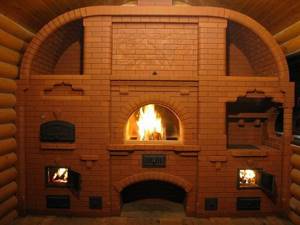
A stove for which the brick will not contain changes in shade, cracks, chips or deformations is the key to a strong and reliable building. The use of bricks with minimal chips and cracks is permissible only for the first two rows, at the moment when you lay out the base of the stove.
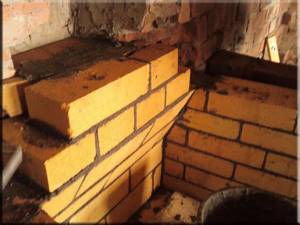
The adhesive composition must be homogeneous and free from impurities, lumps and foreign objects.
To assemble the main part of the stove, choose only high-quality red brick. To assemble the firebox and chimney, only fireclay bricks are used. The adhesion solution must include clay and sand. When building a foundation, choose the highest quality cement with a marking of at least M300-400.
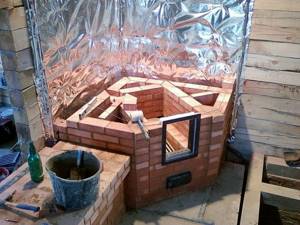
For the convenience of masonry work, it is necessary to first soak the red brick in plain water. Thus, the adhesive composition will not be absorbed in large quantities, and the masonry will be as strong as possible.
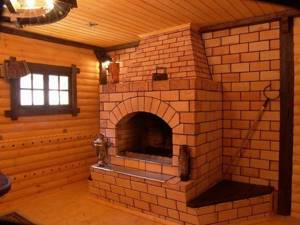
The brick is soaked until no more air (bubbles) comes out of it when immersed in water.
